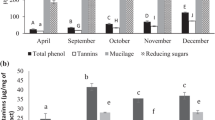Abstract
Aloe arborescens plants, originating from the deserts of South Africa, are grown in the Introduction Garden at Sede Boker in the Negev Desert of Israel. In previous studies, we developed agro-technical methods to raise the content of secondary phenol metabolites (SPhMs) in the Aloe leaves. Plants that are subjected to repeated leaf pruning respond by increasing the content of their SPhMs. The SPhMs found in Aloe arborescens include barbaloin, aloenin and derivatives of aloeresin. Such compounds are used for many purposes, including human skin protection from sun and fire burns and high radiation, as products of the pharmaceutics and cosmetics industries, and as food supplements for treating stomach ulcers and diabetes. In the current study, the SPhMs were separated from pruned leaves of the same A. arborescens plants at the same time by two methods: (1) exudation by squeezing the tissues of the leaves, (2) immersion of the leaves' pruned cut bottom in water and collection of the extract. The exudates and extract were frozen, freeze-dried to a powder and the SPhMs were then separated by chromatography. The yield of powder from water extraction from pruned leaves was much lower than the yield from the exudates. However, higher percentages of the powder from the water extraction contained SPhMs (between 80 and 92.7%). The content of powder in leaf exudates from pruned leaves was much higher because the SPhMs were squeezed out from the cells and tissues. However, the percentages of SPhMs in this powder were much lower (between 39 and 62%).





Similar content being viewed by others
References
Barnad DL, Huffman JH, Morris JL, Wood SG, Hughes BG, Sidwell RW (1992) Evolution of the activity of anthraguinons, anthrones and anthroguinone derivatives against human cytomegalovirus. Antiviral Res 17:63–77
Capasso F, Borrelli F, Capasso R (1998) Aloe and its therapeutic use. Phytother Res 12:s124–s127
Chauser-Volfson E, Gutterman Y (1996) The barbaloin content and distribution in Aloe arborescens leaves according to the leaf part, age, position and season. Israel J Plant Sci 44:289–296
Chauser-Volfson E, Gutterman Y (1998) Content and distribution of anthrone C-glycosides in the South African arid plant species, Aloe mutabilis, growing in direct sunlight and in shade in the Negev Desert of Israel. J of Arid Environ 40:441–451
Chauser-Volfson E, Shen Z, Hu Z, Gutterman Y (2002) Anatomical structure and distribution of secondary metabolites as a phereferial defence strategy in Aloe hereroensis leaves. Bot J Linn Soc 138:107–116
Chauser-Volfson E, Gutterman Y (2004) Influences of leaf pruning on the content of the secondary phenolic metabolites barbaloin, aloeresin and aloenin, in the leaves of Aloe arborescens. S Afr J Bot 70(4):582–586
Dagne E, Bisrat D, Viljoen A, Van-Wyk B-E (2000) Chemistry of Aloe species. Curr Org Chem 4:1055–1078
Duke JA (1989) Handbook of medicinal herbs. CRC Press, Boca Raton
Furukawa F, Nishikawa A, Chihara T, Shimpo K, Berru H, Kuzuy L IS, Hirose M (2002) Chemopreventive effects of Aloe arborescens on N-nitrosoboxopropyl amine-induced pancreatic carcinogenesis in hamsters. Cancer Lett 178(2):117–122
Gribel NV, Pashinskii VG (1986) Antimetastatic properties of Aloe juice. Vopr Onkol 32(12):38–40
Gutterman Y, Chauser-Volfson E (2000) The distribution of the phenolic metabolites barbaloin, aloeresin and aloenin, as a peripheral defence strategy in the succulent leaf parts of Aloe arborescens. Biochem Syst Ecol 28:825–838
Gutterman Y, Chauser-Volfson E (2000) Peripheral defense strategy: variation of barbaloin content in the succulent leaf parts of Aloe arborescens Miller (Liliaceae). Bot J Linn Soc 132:385–395
Gutterman Y, Chauser-Volfson E (2006) Changes in secondary phenolic metabolites during storage as an aqueous suspension in comparison with the content in harvested Aloe arborescens leaves. Int J Food Sci Technol 41:662–666
Kodym A, Bujak T (2002) Physiochemical and microbiological properties as well as stability of ointments containing aloe extract (Aloe arborescens Mill.). Pharmazie 57(12):834–837
Reynolds T (2004) Aloes: the genus Aloe. CRC Press, Boca Raton, 386pp
Reynolds T, Dweck AC (1999) Aloe vera leaf gel: a review update. J Ethnopharmacol 68:3
Sakai K, Saitoh Y, Ikawa C, Nishihata T (1989) Effect of water extracts of Aloe and some herbs in decreasing blood ethanol concentration in rats. II. Chem Pharm Bull (Tokyo) 37(1):155–159
Sakai R (1989) Epidemiologic survey on lung cancer with respect to cigarette smoking and plant diet. Jpn J Cancer Res 80:513–520
Saleh RM, Abd El Alim MA, El Hosari AA (1983) Corrosion inhibition by naturally-occurring substances: constitution and inhibiting property of Aloe plants. Corros Prevent Cont 30(1):9–10
Shimpo K, Chihara T, Beppu H, Ida C, Kaneko T, Nagatsu T, Kuzuya H (2001) Inhibition of azoxymethane-induced aberrant crypt foci formation in rat colorectum by whole leaf Aloe arborescens Miller var. natalensis berger. Phytother Res 15(8):705–711
Shioda H, Satoh K, Nagai F, Okubo T, Seto T, Hamano T, Kamimura H, Dano I (2003) Identification of Aloe species by random amplified polymorphic DNA (RAPD) analysis (in Japanese). Shokuhin Eiseigaku Zasshi 44(4):203–207
Sokal RR, Rohlf EJ (1981) Biometry. Freeman, San Francisco
US Pharmacopeia XX (1990), the National Formulary XVII, United States Pharmacopeial Convention, Rockville, pp 37
Yagi A, Tsunoda M, Egusa T, Akasaki K, Tsuji H (1998) Immuno-chemical distinction of A. vera, A. arborescens and A. chinensis gels. Planta Med. 64:277–278
van Wyk BE, Smith G (1996) Guide to the Aloes of South Africa. Briza Publication, South Africa, 302pp
Acknowledgments
The authors wish to thank Mrs. Sigal Rosenfeld and Mrs. Zoe Grabinar for the editing of this paper and for the useful comments.
Author information
Authors and Affiliations
Corresponding author
Rights and permissions
About this article
Cite this article
Gutterman, Y., Chauser-Volfson, E. The content of secondary phenol metabolites in pruned leaves of Aloe arborescens, a comparison between two methods: leaf exudates and leaf water extract. J Nat Med 62, 430–435 (2008). https://doi.org/10.1007/s11418-008-0252-1
Received:
Accepted:
Published:
Issue Date:
DOI: https://doi.org/10.1007/s11418-008-0252-1




